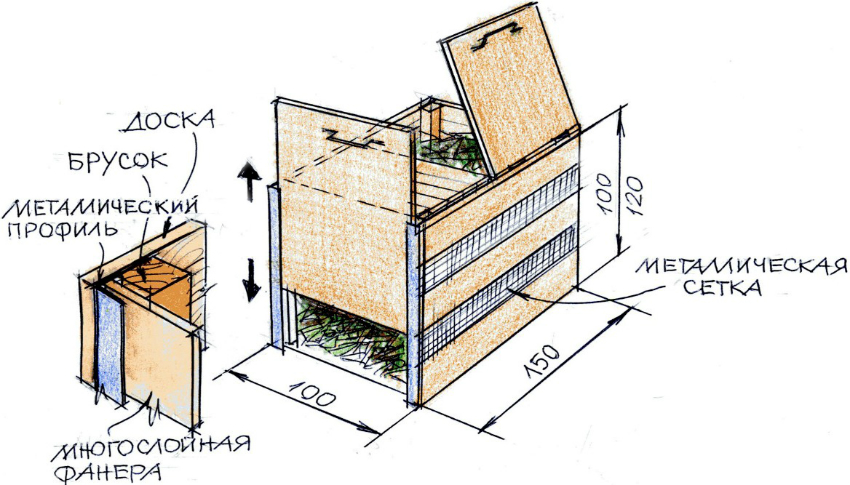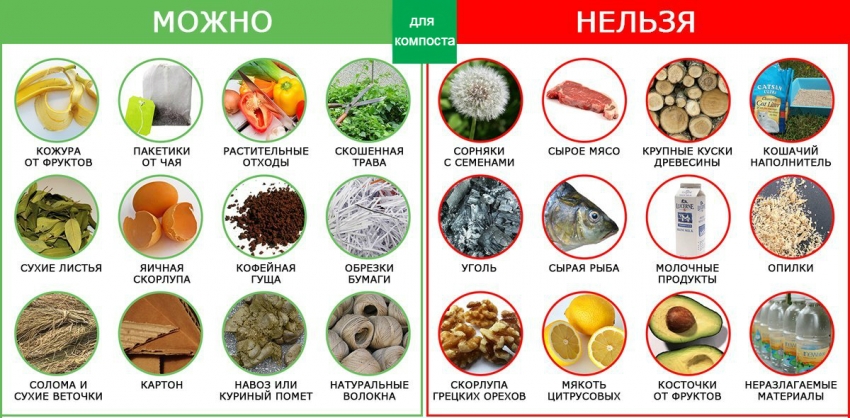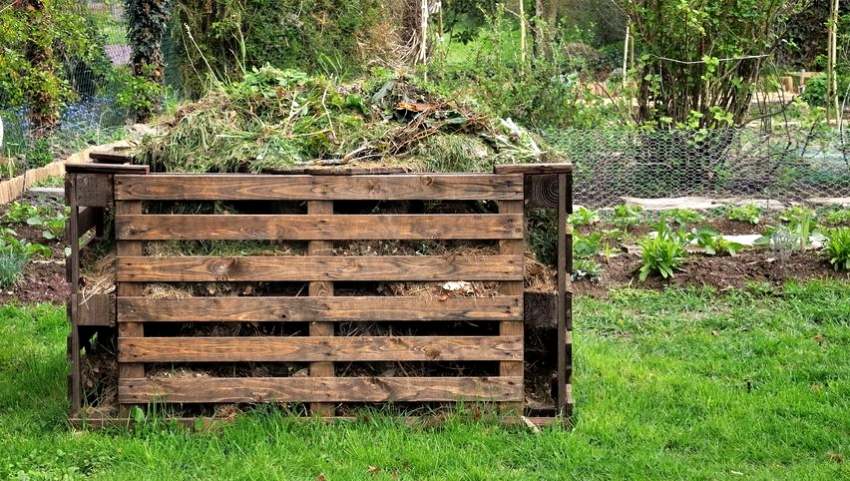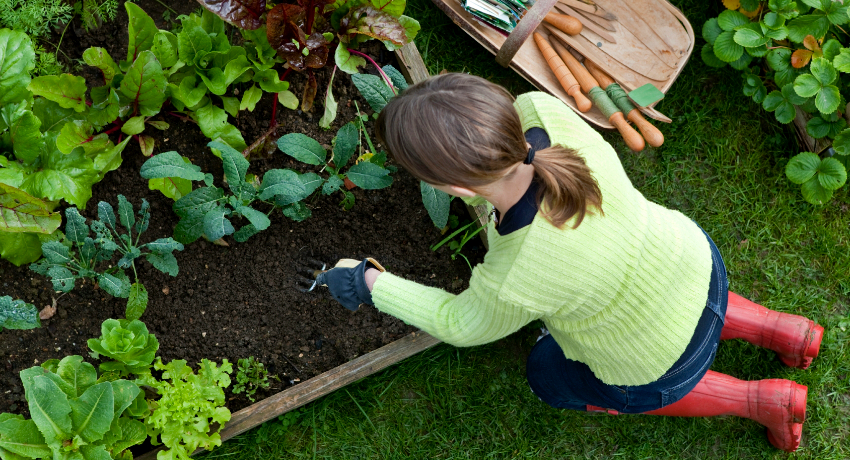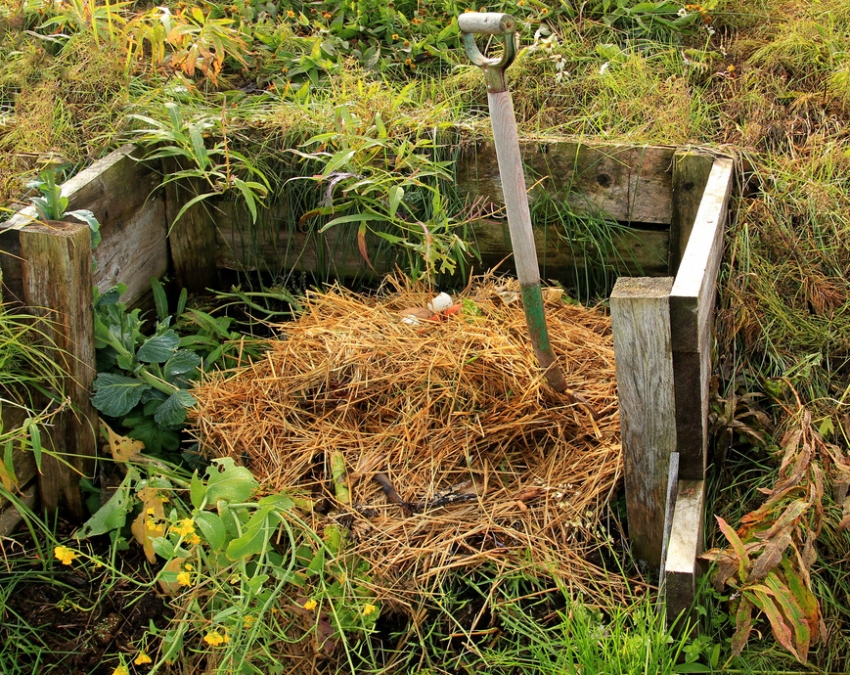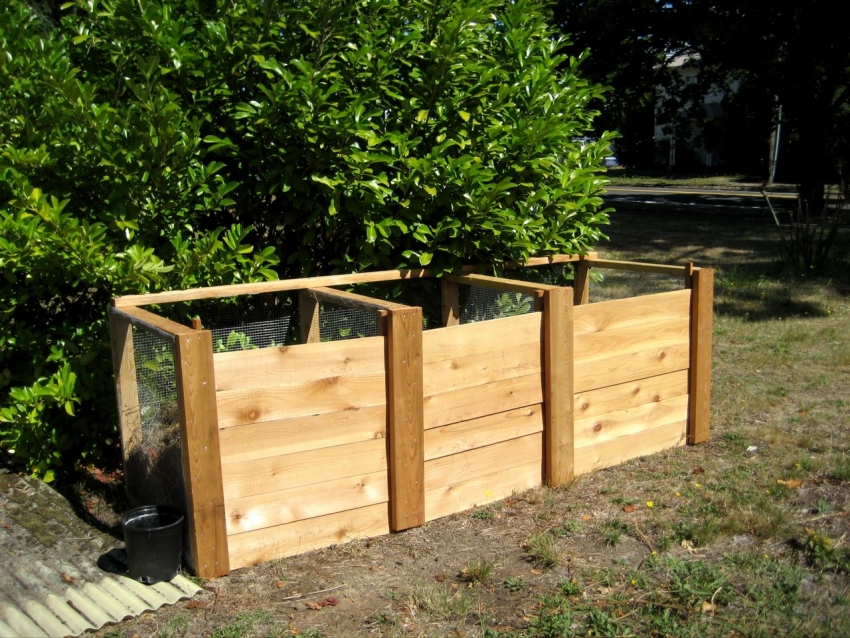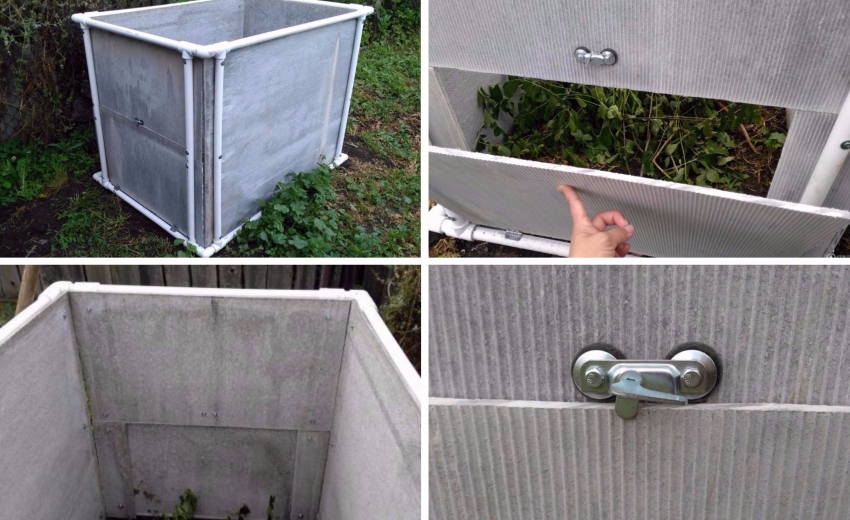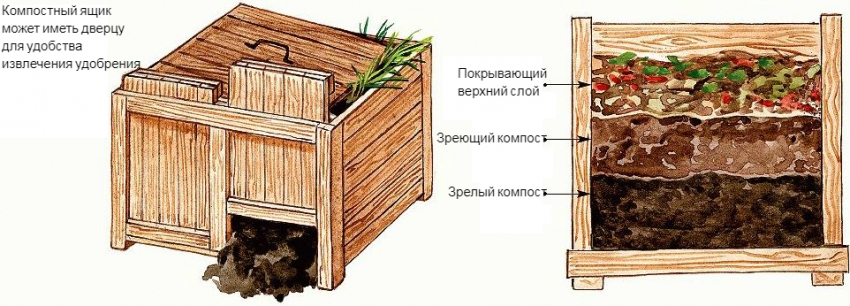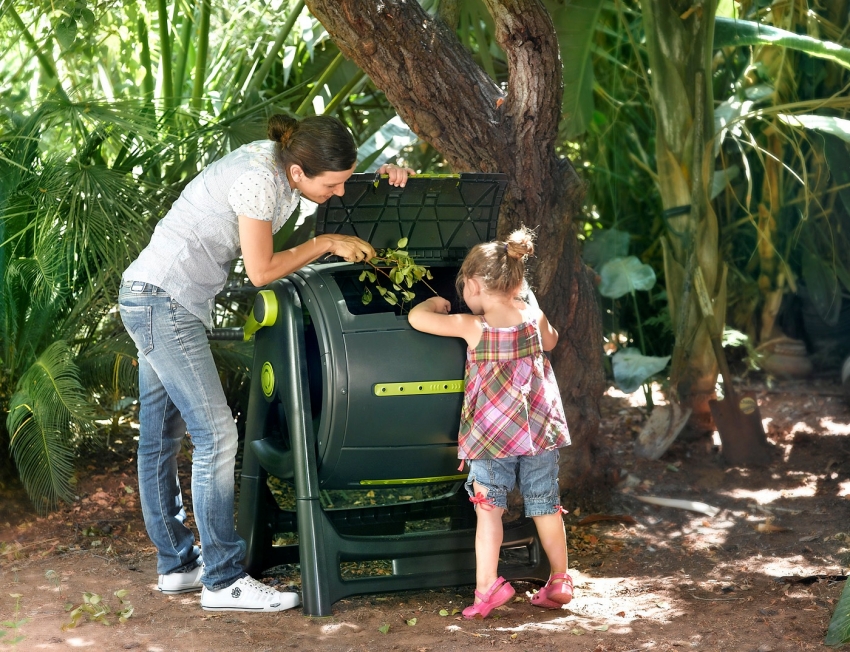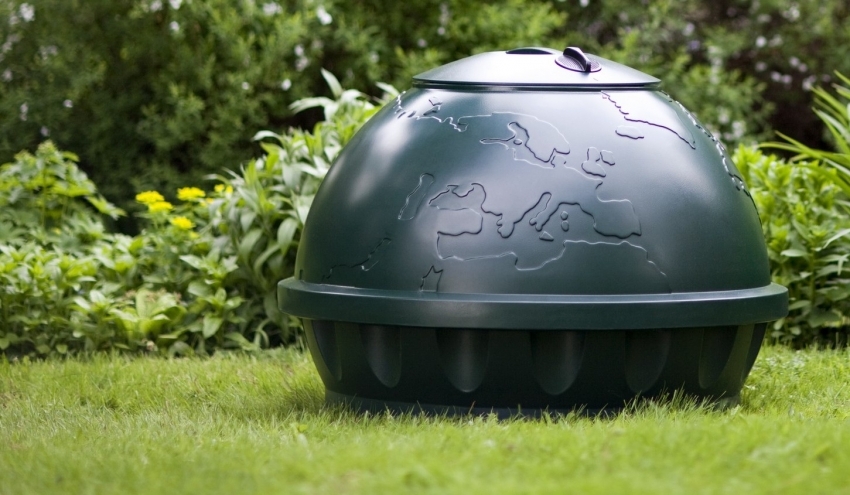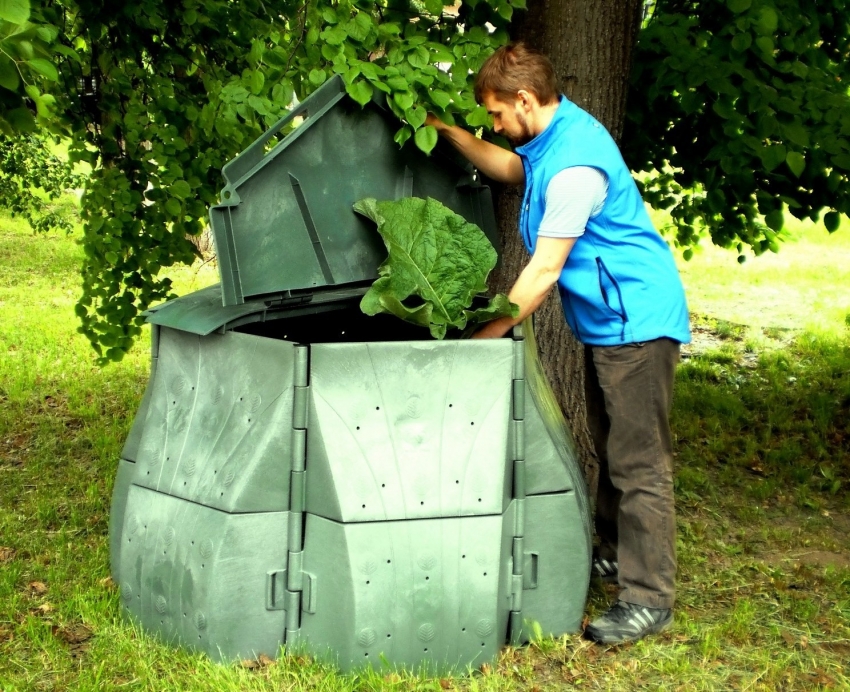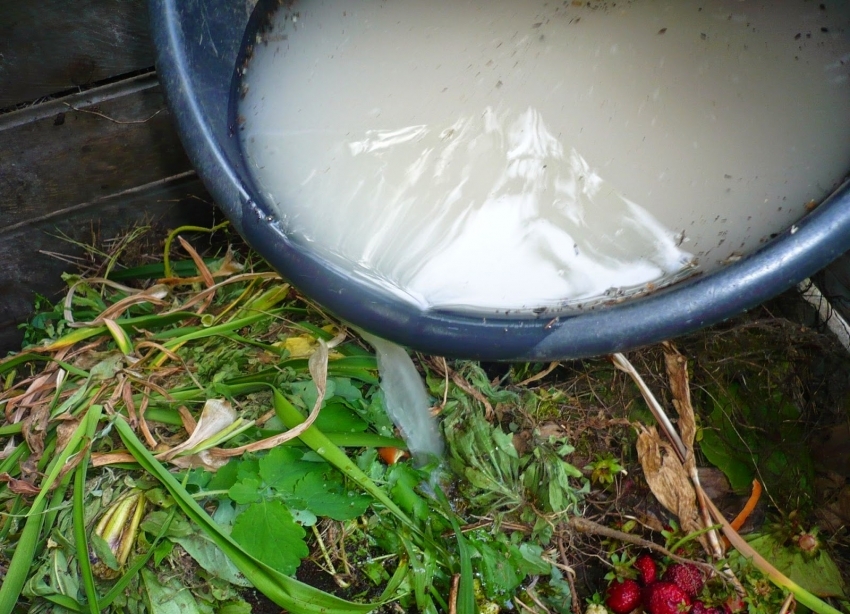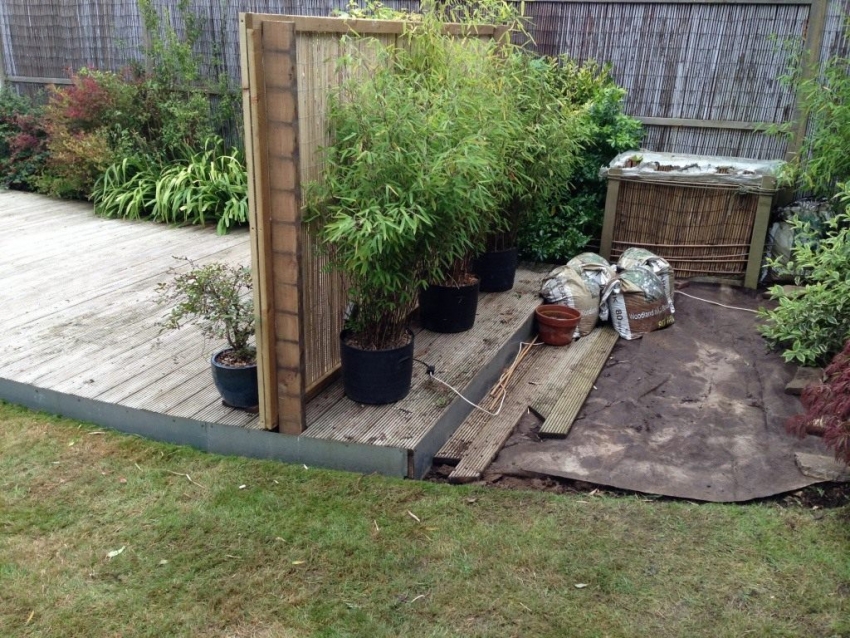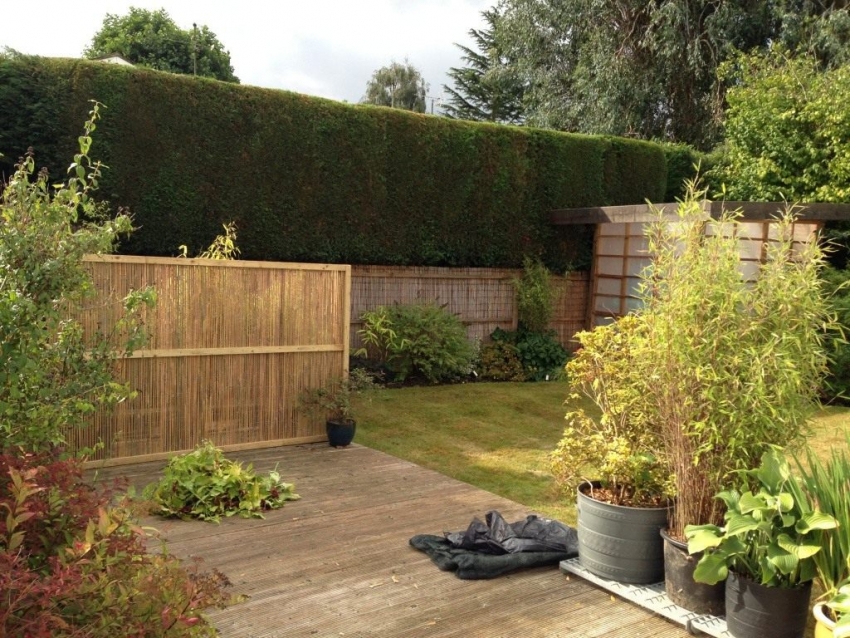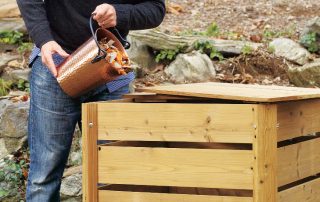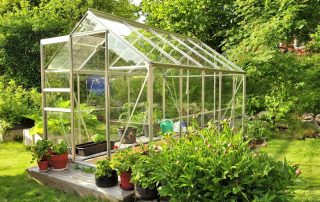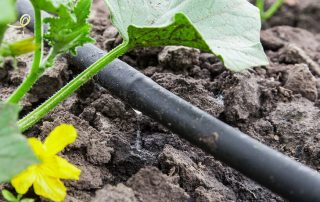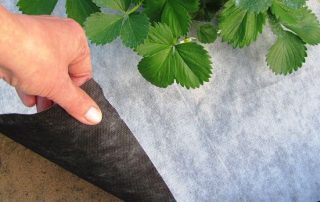The better the quality of the soil, the richer the crop grown on this land will be. But it so happens that the initial data is not very good, and you have to fertilize the soil. You can use various fertilizers for this, but it is best to make a compost pit, which will become a source of environmentally friendly material. Consider how a compost pit should be made with your own hands: manufacturing options and materials suitable for this purpose.

With a compost pit or bin, you can create a nutritious soil for your garden and horticultural plants
Content [Hide]
- 1 How to make a compost pit: design features of this type
- 2 What you can and cannot put in a compost pit
- 3 Features of compost heap care: expert recommendations
- 4 Compost pit: what it is and what it is for
- 5 DIY compost pit: manufacturing options and design requirements
- 6 DIY compost pit: manufacturing options, photo examples
- 7 DIY compost box: manufacturing options and instructions
- 8 Compost pit-dry closet: what is it?
- 9 Criteria for choosing a ready-made composter for a summer residence
- 10 How to choose and buy a compost pit: an overview of the most popular brands and models
- 11 Compost pit products: features and benefits of using
- 12 How to arrange a compost pit in the country with your own hands
- 13 How to make a compost pit with your own hands: video instruction
How to make a compost pit: design features of this type
In order to understand how to properly make a compost pit, you first need to figure out what it is used for. Typically, a compost pit is used to dispose of organic waste, which, as a result of the decay process, turns into organic fertilizer. There are many design options and each owner can only choose the most suitable option for himself.
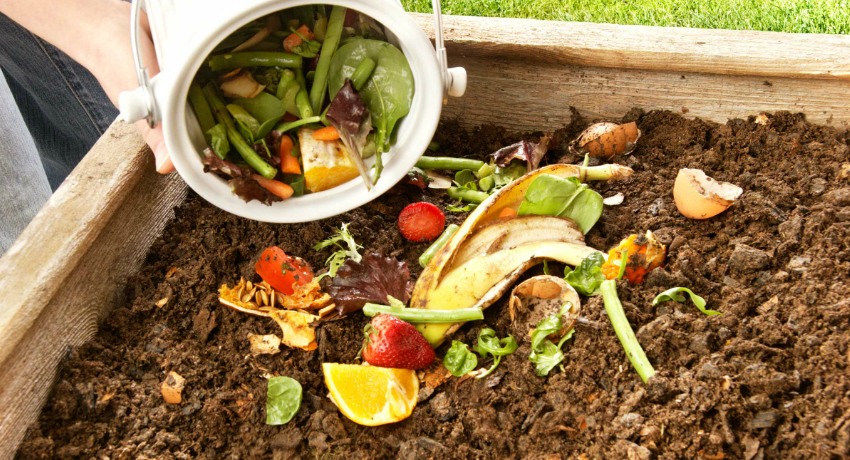
Following the rules for laying layers and fertilizers in a compost pit, you can get nutritious soil in a short time
The compost heap does an excellent job with the disposal of cut grass and fallen leaves. Under the influence of time, moisture and microorganisms, it all turns into a fertilizer that can be used to grow all types of crops, both in gardens and in the vegetable garden.
Making a compost pile of organic fertilizers with your own hands is not difficult at all, especially since there are many ideas for independent implementation that can be used as a basis. You can make your own compost pit using pallets, which are usually used for transporting and storing building materials. They can be bought at a fairly low price, or it is quite possible, simply to find them on your own site.
How to make a compost pit in the country: choosing a location
When talking about arranging a compost heap, one cannot but mention the importance of its correct location. First of all, the structure must be sufficiently distant from residential buildings. In addition, the place of its installation should be well blown by the wind in order to avoid stagnant air and the concentration of unpleasant odors emanating from it. In addition, access to the compost must be ensured so that the process of adding raw materials or removing finished fertilizer is as comfortable as possible.
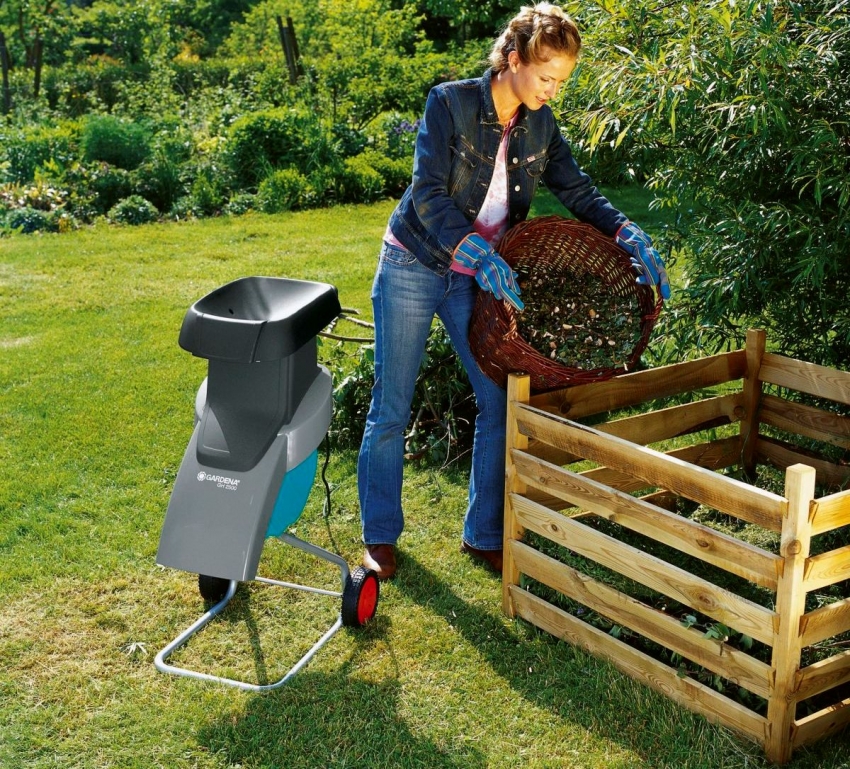
In order for the decay processes in the compost bin to proceed faster, large branches and waste should be chopped
Helpful advice! In order for the decay process to proceed faster, it is recommended to periodically stir the layers inside the heap. Therefore, even at the stage of planning and arrangement, it is worth considering how this can be done.
In addition, the following selection criteria should be taken into account when choosing a site suitable for a compost pit:
- the selected location should be located at a sufficiently large distance from any source of drinking water, for example, a well or a well. The distance between these objects must be at least 25 m;
- if the site is not evenly located, but under a slope, then a compost pit should be made below the water level (preferably at the lowest point of the site). This will prevent the ingress of decay effluents and clean water;
- in advance, it is worth asking about the most frequent direction of the wind, since the pit often becomes a source of a rather strong and unpleasant odor, and can cause discomfort to both you and your neighbors;
- it is worth making sure that there is not only a free approach to the pit, but also enough space to be able to bring in waste or remove the finished compost with a wheelbarrow.
Helpful advice! It is advisable to choose a shaded place for the compost pit, since the sun's rays negatively affect the decay process, significantly slowing down the composting process.
What you can and cannot put in a compost pit
In order for the fertilizer obtained as a result of rotting to be of high quality and bring benefits to plants, and not harm, each summer resident needs to familiarize himself with the list of those products that may or may not be added to compost in advance. So, great for composting:
- grass, weeds, leaves, hay, straw, etc .;
- berries, fruits and any cleaning from them (raw);
- waste from wood products that have not been painted;
- shredded paper products (napkins, bags, cardboard);
- waste from tea, coffee or cereals;
- branches and roots of trees after chopping;
- needles;
- herbivore manure (only two years old);
- wood ash.
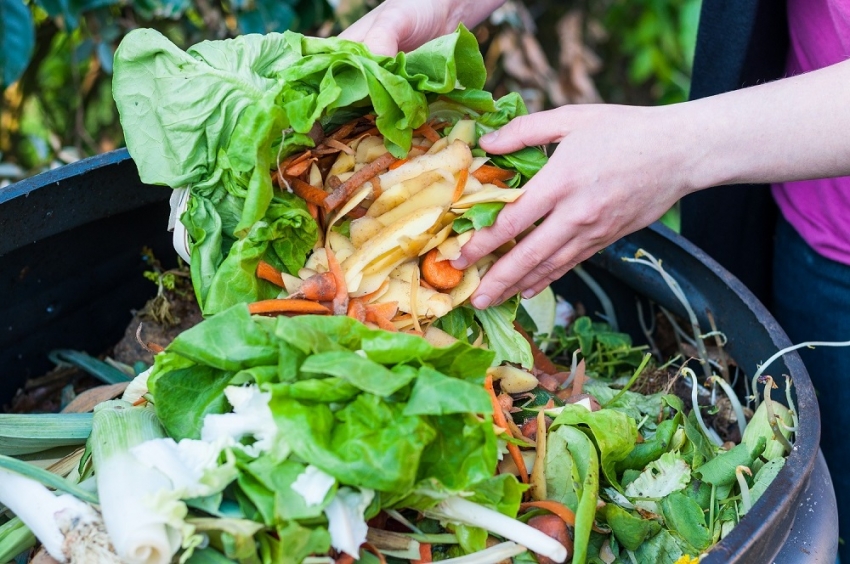
In order to obtain the highest quality compost, you should carefully consider the selection of waste for the compost pit.
Important! The percentage of cleanings in the compost from products such as potatoes and tomatoes should not exceed 15-20%.
It is strictly forbidden to add to the compost heap:
- any plants that have been affected by pests;
- plants affected by diseases such as powdery mildew, late blight, etc.;
- pet excrement, as it can be contaminated with helminth eggs;
- bones and leftovers from meat products.They will provoke an extremely unpleasant odor, and also become food for rats;
- inorganic waste - plastic, rubber, synthetic fabrics and metal;
- plants that have been treated with herbicides;
- the remains of cabbage, the rotting of which provokes an extremely strong and unpleasant odor.
As for composting weeds, experts recommend putting them in a separate pile, which is covered with a film on top. So, the risk that the plants will take root again is excluded and you can count on their death with one hundred percent probability.
If you add weeds to a common heap, then you often have to deal with the fact that perennial plants take root, especially if, as a result of regular watering or rains, the humidity is high enough.
Important! To accelerate the process of rotting waste, it is recommended to preliminarily subject them to shredding. This is especially true for items such as branches, roots and paper products.
Features of compost heap care: expert recommendations
Having figured out what you can put in the compost pit, and what you can't, it remains only to familiarize yourself with the rules for caring for waste in order to ensure that they decompose as efficiently as possible. Moreover, the duration of the period during which the compost will be formed directly depends on the correctness of the care carried out:
- moisture is the most important indicator that affects waste decay and compost formation. In order to maintain the desired level, it is recommended to periodically water the heap from a watering can. At the same time, it is important that in the end it turns out wet, but not wet, since an abundance of water will negatively affect the viability and activity of bacteria;
- once a month, you need to thoroughly stir the pile, thus providing oxygen access. This allows the waste to burn out rather than rot. At the same time, if there is no opportunity to completely dig everything up, you can use the pitchfork and pierce the bunch in as many places as possible;
- to accelerate the maturation process of compost requires the addition of nitrogen, which is found in large quantities in green parts of plants, as well as in slurry.
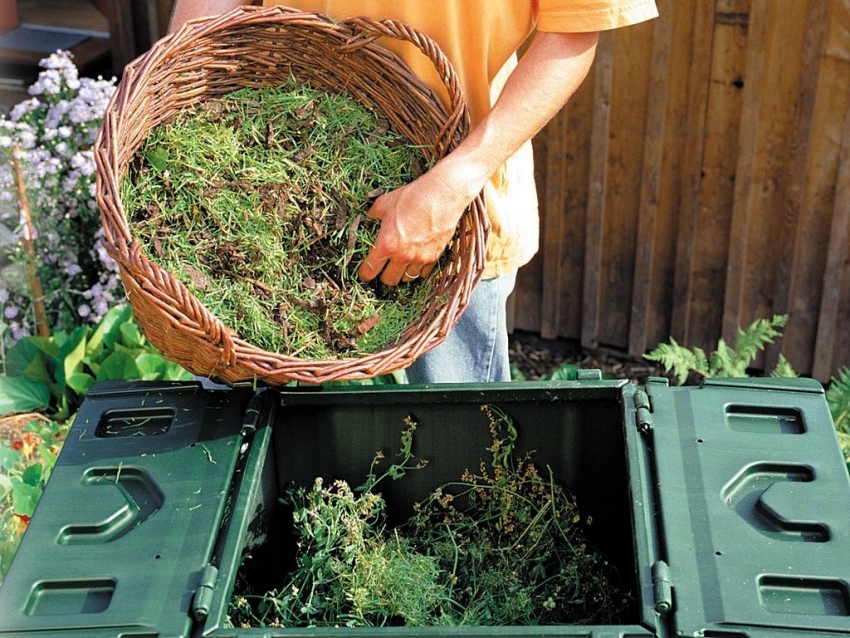
In order for the composting process to proceed correctly, you should carefully consider the choice of a place for the composter.
It usually takes 1-1.5 years to form high-quality compost. During this time, almost any waste and residues will fully decompose. The readiness of the compost can be recognized visually and by smell. The finished mixture is a crumbly brown mass and has the smell of forest earth.
Compost pit: what it is and what it is for
The issue of using compost is one of the most popular. After all, not every summer resident knows how and why to use the resulting mixture, and how great is its benefit. In fact, it is possible to fertilize the soil with compost for almost any plant. Cucumbers, peppers, zucchini and pumpkin respond best to such feeding. The result can be seen already in the next harvesting season - the fruits grow large, have a bright and rich color, taste and aroma are well expressed.
But there are also plants for which compost is not so useful. For example, root crops, tomatoes, melons and watermelons should not be fertilized abundantly in this way, since this leads to the fact that the yield decreases, and the amount of green mass, on the contrary, increases.
Strawberries react well to compost, especially if you first cut them "at the root" and overlay them with a semi-decomposed composition. Then all this needs to be watered, and all that remains is to wait for new fresh foliage, as well as a bountiful harvest next season.
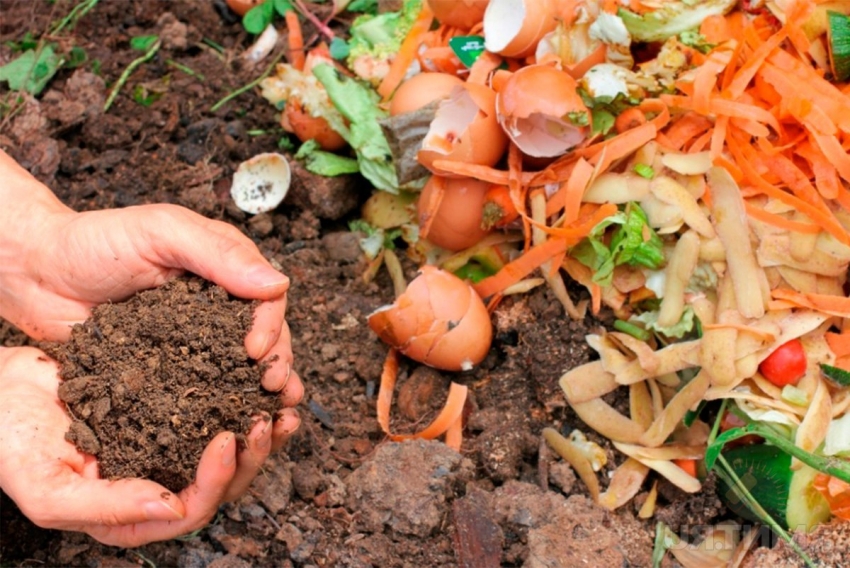
With the help of compost, you can naturally enrich the land on the site, thereby increasing the quantity and quality of the crop
DIY compost pit: manufacturing options and design requirements
In order to properly build a compost pit, you need to understand how the compost heap should be arranged. There are many DIY manufacturing options, but first of all, you should pay attention to the fact that it should consist of three parts. In this case, it is necessary to install 8 support posts, each of which must be treated with a protective agent.
Helpful advice! Machine oil, fuel oil or even tar can be used as a protective composition for the posts.
You can use a fence canvas as a fence on one of the sides, and boards are better for the rest. Partitions are constructed from them, in which holes for ventilation are necessarily left. This contributes to the course of the decay process. A door must also be installed that allows access to the compost.
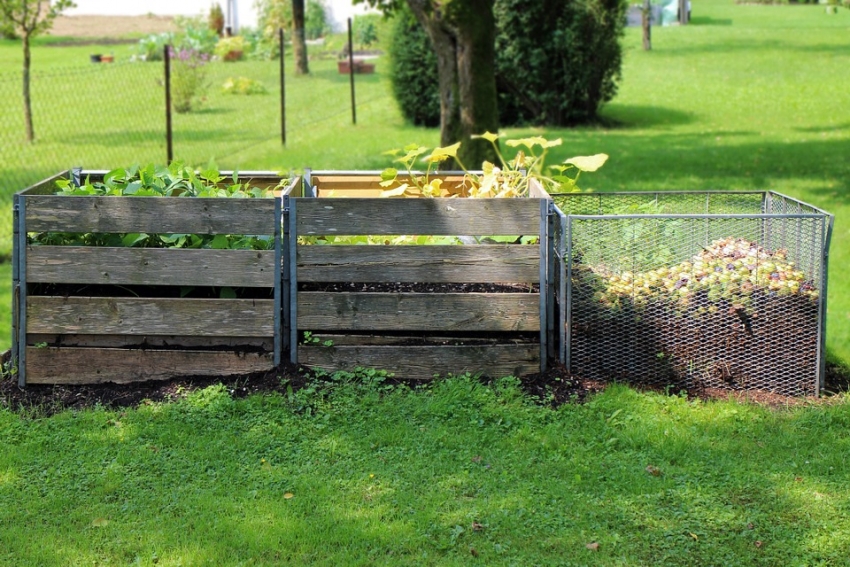
The compost heap can be divided into compartments for easy disposal of compost and laying of new layers
Making a compost pit in the country with your own hands involves ensuring the proper level of ventilation and at the same time protecting the contents from precipitation. So that the compost heap does not turn into a swamp, it must be covered with a special cover of a suitable size during precipitation. And if the weather conditions are not too harsh, then it is quite acceptable to use plastic wrap for this purpose.
Another option is to use building pallets that are pre-dismantled. Using a circular machine, the boards can be divided into individual elements, and then assembled from them into a suitable structure. In this case, it is better to fasten the boards vertically. The front board can be fixed with an adhesive. To give such a structure stability, it is necessary to use the building level and trim the lower planks.
It is also important that the height of the walls of a homemade composter is such that it is convenient for a person of any height to add, stir up and remove compost.
Interesting!You can pay attention to the construction of compost pits made using Finnish technology. In this case, some design features are of interest, for example, when you extract humus from one compartment, it is automatically filled with raw materials from the adjacent one.
DIY compost pit: manufacturing options, photo examples
The type of compost pit is determined based on several factors. One of them is the installation method. Let's consider all the existing options:
- allocation of a certain place for organizing a compost pit. At the same time, a foundation pit is initially prepared, which is very similar to a well, but at the same time has a shallower depth. The walls of the pit are additionally strengthened to prevent soil shattering and are sheathed with an indent of 20-25 cm from the bottom. This distance is necessary in order to provide the microorganism with free access to waste;
- Another option is to install a special container in the garden area for collecting waste and processing it into compost. This method allows you to get the finished product at any time. This design is based on a pit with a formwork, as well as a special box made of boards. When implementing this option, it is extremely important to pay due attention to the organization of ventilation;
- a compost pile with your own hands is the easiest way to solve the problem. To do this, it is enough to make a substrate consisting of sand, gravel and dry grass. Waste is simply stacked on top, which over time will themselves begin to rot.
Related article:
Step-by-step making warm beds with your own hands in spring: popular technologies
Detailed technology for the construction of structures: soil preparation, fabrication of the frame, its installation and filling.
You can make a do-it-yourself compost bin using many different technologies and instructions. The proposed designs can be distinguished by materials that are required for work, dimensions, properties and ease of use.
Helpful advice!Regardless of the type of structure chosen, before starting to lay the raw materials inside the structure, it is necessary to thoroughly loosen the bottom and install the ventilation holes.
DIY compost box: manufacturing options and instructions
Before making a compost pit with your own hands, it is advisable to consider as many options and designs as possible that can be used for this purpose. Let's take a closer look at the instructions for making the most popular boxes made from various materials.
Garden compost bin: installation and operation features
A garden composter may well be presented as a large box, divided into several sections. Usually two or three compartments are made, but experts strongly recommend stopping at the option with three sections, since each of them has its own purpose: the first serves for laying waste, the second is intended for waste ripening, and the third contains ready-made compost.
Depending on the individual wishes of the owner, the composter can be stationary or mobile (move on wheels). In this case, the recommended height of the box should not exceed 1 meter, and the size of each section should be about 1-1.5 meters.
Important! All wooden elements must be treated with a special protective compound designed to provide the material with reliable protection against harmful insects, as well as moisture.
To make a compost box with your own hands, you need to adhere to the following procedure:
- 8 wooden blocks are dug into the ground;
- With the help of boards, also pre-opened with a protective compound, partitions are constructed. To do this, they are attached to the supports at some distance from each other.
- In the front part, two compartments should be sheathed only to the middle, and only one bottom board is nailed to the third. On the first two, doors are mounted on top.
- The back and end parts are fully sheathed.
- The entire structure is covered with two layers of moisture resistant paint.
- In the end, handles, latches, etc. are attached.
At the bottom of such a box, drainage must necessarily be laid, which may consist, for example, of dry tree branches. Immediately after that, you can go directly to laying waste inside the structure.
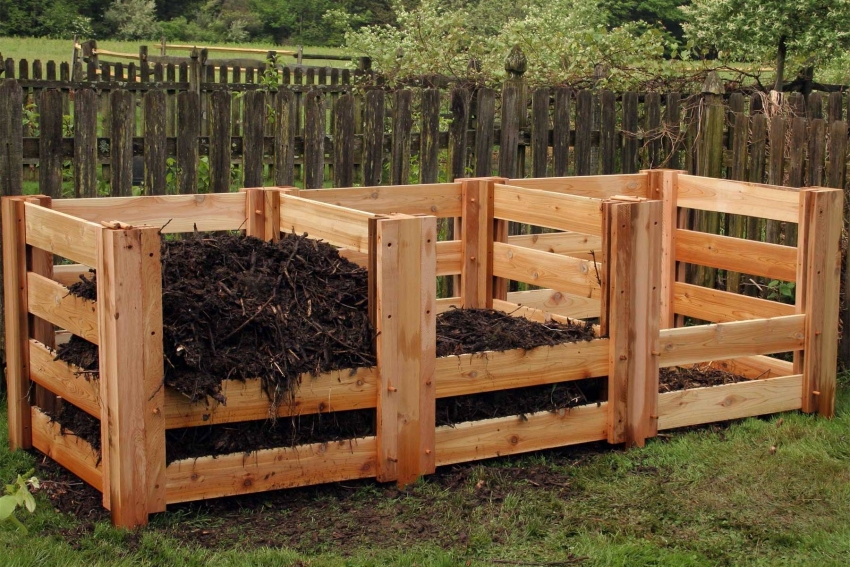
In the case of using wooden elements for the construction of a composter, the material must be treated with special wood preservatives
How to make a compost pit in the country using wooden planks
A compost pit is an excellent solution, if necessary, not to spoil the appearance of the site with the appearance of a heap of waste. Formation of fertilizer in such a structure takes much longer, and in order for the process to proceed as correctly and efficiently as possible, it is important to take care of the correct arrangement in advance and ensure access to the required amount of oxygen.
The order of work:
- First of all, it is necessary to dig a compost pit, the width of which will be 1.5 m, the length of 2 m, and the depth of about 1 meter.
- In the corners, you need to dig in wooden bars, observing a distance from the walls of 20 cm on each side.
- In 5 cm increments, boards are attached to these posts.
- The resulting box is divided into two parts using a wooden shield.
The bottom of the compost pit is filled with a ten centimeter layer of bark, twigs and straw.Such a mixture will take on the role of drainage, which will allow to remove excess moisture and additionally ventilate the raw materials.
Initially, only one of the compartments should be filled with waste. Then, when one is half full, the compost must be transferred to the second compartment. This procedure will enrich it with oxygen as much as possible.
Important! The bottom and sides of the composter do not need to be covered with anything so that earthworms can freely get inside, which take an active part in the waste processing process.
How to make a slate compost bin
Slate is a durable material that is great for creating a structure designed to collect and process organic waste into compost. The procedure for creating a suitable structure consists of several stages:
- choosing a suitable place and taking measurements in order to determine the appropriate size of the pit;
- according to the marks, a not too large depression is being dug, in the corners of which supports are installed, which can be used as boards or metal pipes;
- slate sheets are installed along the perimeter of the pit;
- using the same sheets, the resulting container is divided into several parts (two or three).
The use of this design is carried out according to all the same recommendations that are given for compost pits made of wood.
How to make a compost pit out of concrete in the country
If you devote a little more time and attention to the process of arranging the compost pit, then as a result, it can serve several decades without problems. To do this, it is enough to concrete it. This can be done as follows:
- you need to dig a hole about 80 cm deep, 2 m wide and 3 m long;
- make formwork inside the pit;
- then you need to prepare a solution consisting of sand, gravel and cement. To do this, pour 5 liters of water into the bucket and add 5 kg of sand and cement to it so that the ratio of dry components is 3: 1;
- the resulting solution is poured into the formwork;
- using wooden boards and a netting (a metal frame is also suitable), a cover is constructed for the pit.
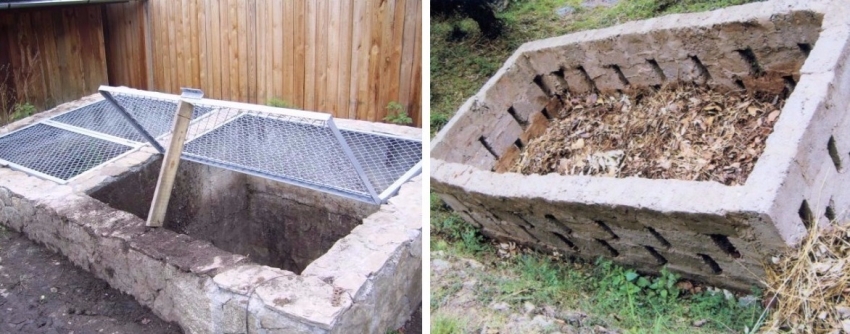
A concrete compost pit is not as convenient as a box, but it is easier to disguise such a structure on the site
It is very important that in the case of using boards for mounting the cover, there is a distance between the elements necessary for proper ventilation.
Compost pit according to Finnish technology: the secrets of installation
The main requirement for structures made using Finnish technology is compliance with certain dimensions. The height and width of the box must necessarily be the same and be 1 m. This is extremely important, because in a smaller box, the raw material will simply dry up, turning not into compost, but into dust. Large sizes are unacceptable for another reason - in this case, there is a risk of burning the contents from too high a temperature.
For the manufacture of such a structure, it is best to use wood. Slate in this case is not a very suitable option, since structures made from it are characterized by a longer period of waste decomposition. Again, a cheap and at the same time quite convenient option is a Finnish compost pit from pallets.
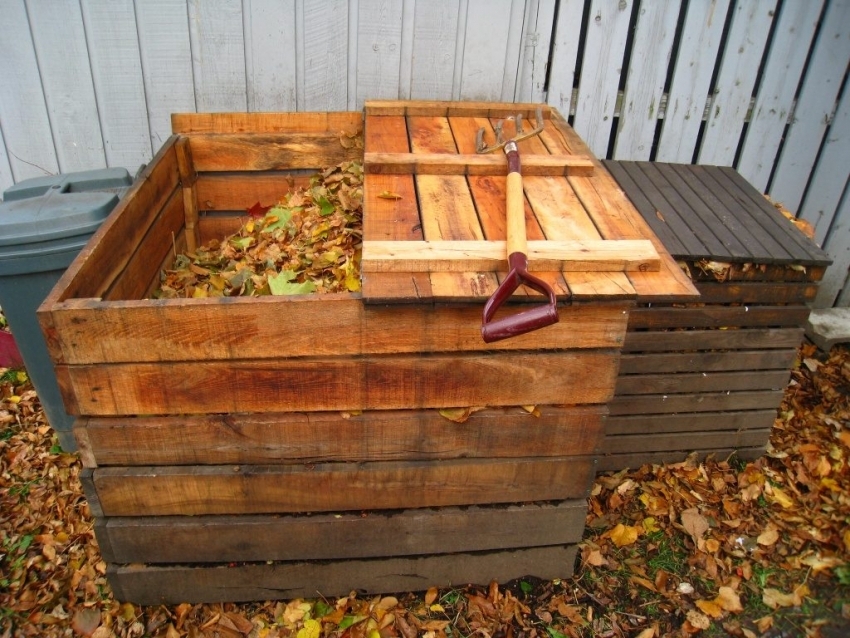
When building a composter using Finnish technology, it is important to observe the exact dimensions of the structure
Algorithm for assembling a compost pit using Finnish technology:
- The frame of the box of the required size is assembled from wood pre-treated with antiseptic agents.
- Then the finished frame is sheathed with boards. Boards are tightly placed only on partitions that separate the compartments. On the side walls, the boards should be spaced with an indent of 1 cm.
- The back wall of the structure is also sewn up with boards at a distance of 1 cm.
- The bottom of the box is covered using a croaker.It is also important to maintain some distance between the elements so that excess liquid can be efficiently drained away.
- In the lower part of the front wall of the structure, a small door is equipped, the height of which is usually 30 cm. It is fastened using ordinary door hinges.
- The roof of the structure is made gable, with one of the slopes attached to the hinges so that it simultaneously acts as a door, making it possible to fill in the waste.
Interesting! In one box, the size of which is 1 × 1 m, you can prepare the amount of compost sufficient to fertilize a plot of land of 5-7 acres.
Compost pit-dry closet: what is it?
Another special type of compost pit is a dry closet, which is also capable of converting human waste products into compost. It is a structure consisting of two containers, each with a volume of 80 liters.
Using this type of dry closet is as follows: after visiting the toilet, you need to turn a special handle, which is responsible for supplying a portion of a special mixture consisting of peat and sawdust. Thanks to this mechanism, the mixture is evenly distributed and falls asleep inside the waste.
It is quite possible to use such a composter-dry closet for the disposal of not too much food waste, simply by throwing it inside and filling it with a dry mixture. When the first container is completely filled, it must be pushed aside and the second one must be installed in place, which can be used in the same way. At this time, the first container will contain the compost mixture, completely ready for use.
Important!The compost obtained in such a composter will be very concentrated. This must be taken into account, and before adding it to the soil, you need to dilute the mixture with soil, sand or peat.
Criteria for choosing a ready-made composter for a summer residence
At the same time, an increasing number of owners of suburban areas are trying to move away from the use of homemade structures, preferring purchased models. Let's consider what advantages and disadvantages the ready-made designs have, and what parameters you need to pay special attention to before making a purchase.
In most cases, preference is given to simple and convenient composters that are easy to assemble and operate on their own. But since the number of offers on the modern market is extremely large, it can be really difficult to independently determine the most suitable option. As a guideline, experts recommend using certain criteria, since the models can be:
- collapsible or solid;
- with temperature sensor;
- with a special device that allows you to loosen the contents;
- with a net instead of the bottom, which provides protection from rodents;
- of various shapes and sizes.

You can build a composter for a summer residence yourself or purchase a ready-made model in a specialized store.
Composters also differ in the material used for their manufacture. So, plastic is the most popular today, since it has a low weight, which allows it to be moved around the site without problems, and its service life is extremely long. If the structure is planned as stationary, then you can also consider the option of purchasing a metal composter. Wooden models can also be found on sale, but they are not very common due to their short service life and exposure to external factors.
How to choose and buy a compost pit: an overview of the most popular brands and models
As examples, consider a few composters that are the most popular and have received a lot of positive feedback from users.
L&T Globe composter: features and characteristics
This model is highly valued by permanent residents of country houses, since it can be used throughout the year, and not every product can boast of this. The L&T Globe was developed by Finnish specialists who took into account the harsh weather conditions of the local climate. This allows the composter to function without any problems even in the most severe winters.
Another advantage of this model is the absence of small and heavy parts, so it is quite easy to operate the device. The working volume of the container is 310 liters, and durable polyethylene was used as a material for the manufacture. In order for the system to function even in the cold season, a 15 mm layer of thermal insulation was provided, which allows maintaining the optimum temperature inside.
Due to the low height of this composter, a person of absolutely any height can fill and empty it. Moreover, for even more comfort, a removable upper part is provided in the design.
Thus, all these design features create the most favorable environment for efficient waste composting. The microclimate that is maintained inside the container promotes the growth and development of microorganisms that can process waste. The developers did not forget about the ventilation system, which is presented in the form of drainage holes in the bottom of the composter.
Important!The ventilation system of this model can be used in two modes: summer / winter. It is important to carry out the switching in a timely manner using the shutter specially provided for this.
Bulbeo composter: features and benefits
This model is the development of Italian specialists, which exists on the domestic markets in two modifications, differing in size (700 and 900 liters). Initially, this model was intended exclusively for processing plant waste, but, as practice shows, it copes well with composting other organic waste.
This composter is a collapsible model and consists of separate parts that can be easily assembled and, if necessary, disassembled again. This allows you to rearrange the container from one place to another and even transport it. Moreover, when disassembled, this design takes up very little space and can easily fit in the trunk of an ordinary passenger car.
Among the main advantages of this choice are noted:
- the ability to get free access to the structure from six sides;
- it is convenient to take out the finished compost thanks to the hinged doors;
- this model looks quite aesthetically pleasing on the site, since it resembles a blooming bud in shape;
- discreet dark green color allows you to organically fit the structure into any landscape design.
Durable plastic is used as a material for this model, which provides reliable protection of the contents from wind and strong temperature extremes. According to the developers, the rounded shape of the walls promotes the maturation of the compost.
There are, of course, ventilation openings to provide the right amount of oxygen. Everyone can easily assemble this model, because this does not require any tools or additional fasteners. The finished structure weighs only 19 kg, and its height is 885 mm.
Compost pit products: features and benefits of using
Having figured out how to make a compost heap, many expect that they will soon be able to use the nutrient fertilizer made in it. But the reality is that the natural maturation of compost can take up to 2 years. Of course, you can just be patient and wait. But you can go the other way, buying a special tool that promotes the maturation of compost and accelerates this process.
Interesting! The issue of using excipients is especially relevant for those regions of the country where the warm period is short. If the warm weather lasts only 2-3 months, then the maturation period of the compost has to be artificially reduced.
So, there are several drugs that are well suited for this purpose and are recommended not only by specialists, but also by real users. They all have different names, but, in general, their principle of operation is the same. As an example, consider the Tamir remedy.
Tamir is an extremely complex preparation, which includes a whole complex of microorganisms, which in the natural environment are responsible for ensuring the decomposition of organic waste and waste. Due to the high concentration of these bacteria, the composting process occurs several times faster, and after 2-3 weeks, full maturation occurs.
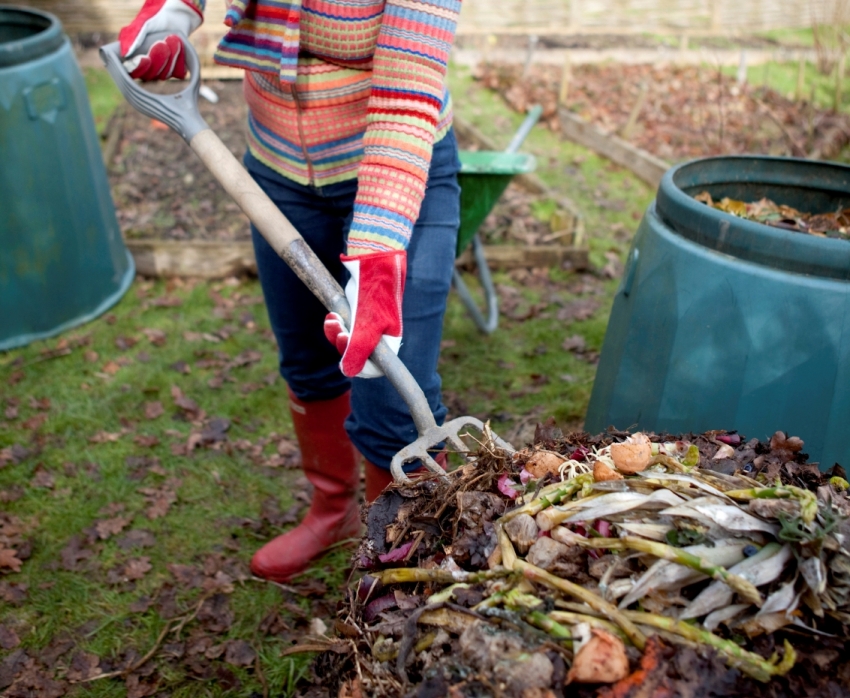
An important step in creating high-quality compost is the process of natural ventilation, which can be enhanced by turning the layers over from time to time.
It is worth noting that the compost obtained in this way is not completely decomposed waste and is slightly different from the usual consistency. But its final decomposition will occur directly in the soil, which will bring even greater benefits to the plants.
Important! It is believed that compost obtained as a result of exposure to auxiliary preparations, like fertilizer, is several times more useful than that obtained naturally. Therefore, answering the common question whether it is possible to use means for compost pits, the answer is unequivocal - it is not only possible, but even necessary.
All means of this type are used according to the following technology:
- if the pile has not yet been formed, then the drug is added on top of each new layer, after which it is poured over with water;
- in the already finished heap, you need to make a depression to the full height, into which the drug and water are added.
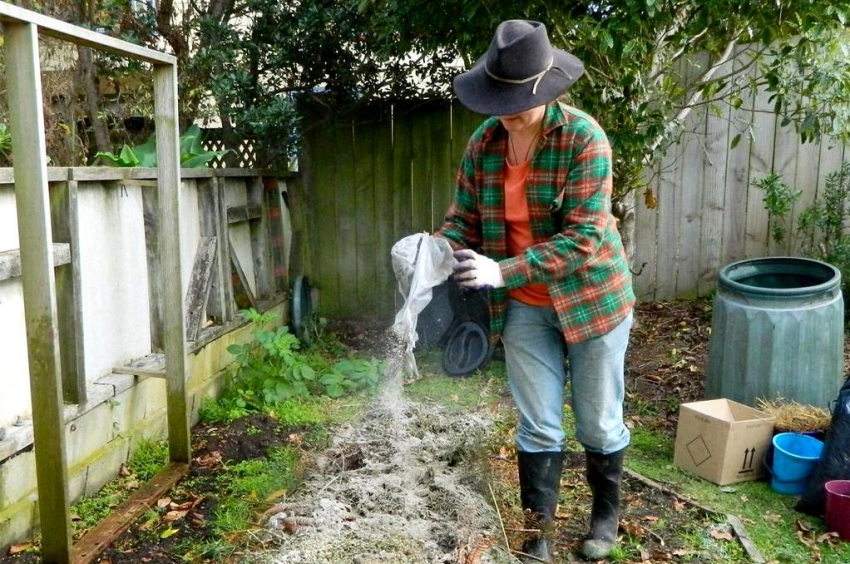
When applying fertilizers to compost, it is important to adhere to the proportions indicated by the manufacturer on the packaging.
Other ways to speed up the maturation of the compost heap
In addition to complex preparations, you can use other methods to stimulate the processing of organic waste and the maturation of compost in the pit. Let's consider each of them in more detail:
- the use of rotted manure, which is quite capable of replacing biochemical preparations intended for composting. At the same time, it is forbidden to use fresh manure, as it can become a source of not only helminth eggs, but also weed seeds, pathogens, etc .;
- a solution made from ordinary yeast. To prepare it, you will need 1 liter of water and about 1 tablespoon of dry yeast. To this is added 200 grams of sugar (1 cup). This solution is poured into the recesses made in the compost heap;
- herbal infusion. To improve the effect, it is mixed with chicken manure or slurry in a ratio of 5: 2. It is important to know that the amount of nitrogen contained in fresh poultry manure is much higher than in manure, which means that the ratio should be different.
Helpful advice! In order for bird droppings to enter the compost heap in a natural way, you can install a feeder above it. This will greatly facilitate and speed up the process.
The methods of accelerating ripening also include artificial humidification of raw materials, its tedding and other measures designed to create the most comfortable microclimate for composting.
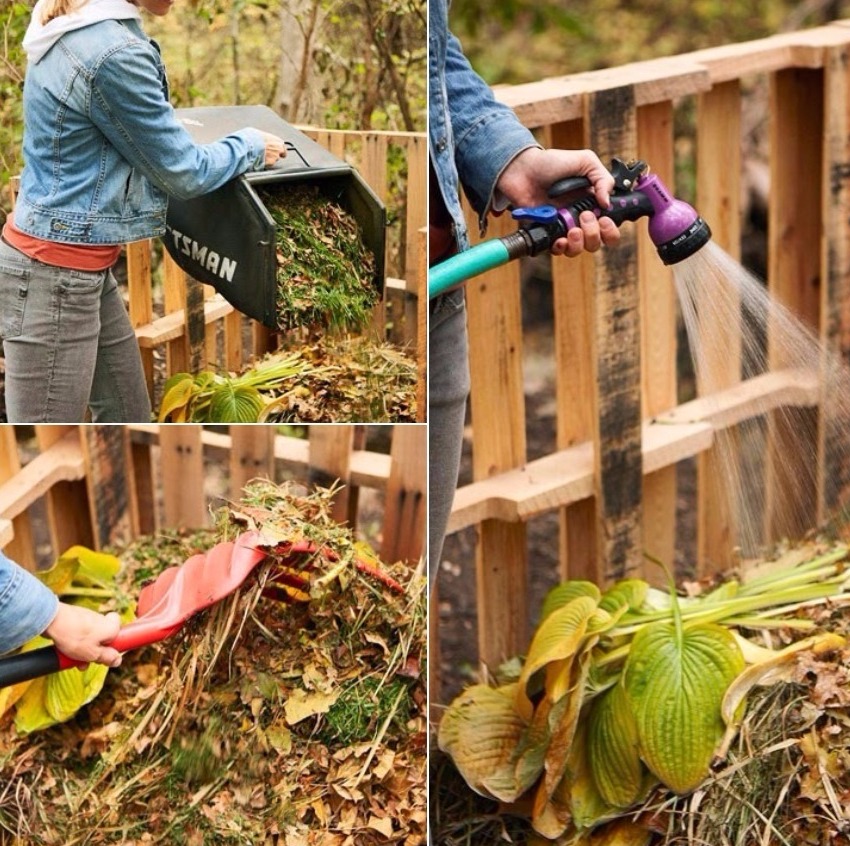
In order for the processes in the compost to proceed quickly, it is necessary to ensure that the heap is moist.
How to arrange a compost pit in the country with your own hands
Whichever structure is chosen for composting, it is unlikely that its appearance will end up being attractive enough. Most likely, no one will want to look at the compost pit, so it will be useful to think about how you can use the original design to improve its appearance.
The problem of masking the compost pit is especially relevant for small plots, since almost the entire territory is in plain sight. Although it happens that even for spacious areas, the owners use different design strategies to make the compost pit more attractive. So, in order to hide such an object, you can use:
- camouflage with plants and hedges;
- artificial decoration and stationary fences.
Work related to the manufacture of artificial fences must be carried out in an open area located at some distance from the location of the compost pit. This is necessary in order to make it more convenient to work and to be able to move freely without being subject to discomfort from the smell exuded by the heap.
The main requirement for such a fence is that it must hide the entire site from the eyes of guests and owners. That is, the compost heap should be completely hidden behind it, and the appearance of the fence should be as attractive as possible and in harmony with the environment.
It is much longer and to some extent more difficult to create hedges for this purpose. But they look much more natural and elegant. The main thing is to pay attention to the choice of a suitable plant, so that in the end the hedge is not too bulky and lush, and does not break the general structure of the site.
Helpful advice!You can use light translucent screens entwined with vines as a fence. They do an excellent job with the task, and at the same time do not take up much space, so they are quite suitable for both large and small areas.
The best ideas for decorating a silo pit
Other elements, such as special screens or screens, can be used to mask the place where the compost heap is located. Bamboo fences have proven to be excellent. Plants also look good if you carefully plant them in a row.
At the same time, it is strictly forbidden to equip a compost pit directly under the fruit trees, as this can lead to their death. There must be some distance between the compost and the plants.
The most popular are the following design methods:
- fruit trees and berry bushes planted in a row;
- potted gardens placed on several levels to hide the entire structure;
- installation of a small architecture object: a gazebo or a fenced barbecue (of course, in this case, you should make sure that the unpleasant smell of rotting waste does not interfere);
- flower beds with tall plants;
- support wall.
Separately, it is worth noting the masking of compost heaps in the event that a plastic container was used for them. In this case, it is not at all necessary to completely mask it. You can use it as a decoration of the site, painting it in a bright color and planting beautiful flowers around.You can draw any drawing on such a container, thus giving it originality.
The easiest way to work is with small compost pits that can be hidden with an abundance of flowers or even shrubs. By the way, the compost yard is a great place to experiment with growing new varieties of annual plants.
You can clearly see how composters for summer cottages are made and designed with your own hands by looking at the training lessons and detailed instructions. You just need to decide which design is best suited in a particular case, as well as take into account your own individual requirements and wishes. Otherwise, there will be no problems, since there are as many options for compost pits with your own hands as there are ready-made models.
